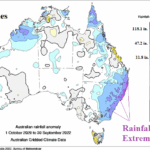Presence of TUTT Leads to a Revised 2022 Tropical Cyclone Season Forecast for Much Lower Amount
09/14/2022, 4:42 am EDT
Explaining the Extreme Rainfall Events in Eastern Australia
10/16/2022, 10:15 am EDTHighlight: Polar ice cap influencing early cold season Eurasia climate.

Fig. 1: Weekly polar ice analysis noting NEW ICE north of Northeast Russia.
Discussion: NEW ICE has appeared north of Northeast Russia into early October (Fig. 1). The expanding ice is shifting toward the Northwest Eurasia Coast. Proximity of the ice to the Northeast Asia continent allows early season cold wind across still-open water to cause ocean-effect snows which surge into Northeast Asia causing above normal early season snow cover (Fig. 2). The snow cover albedo deflects incoming solar radiation quickly back into space cooling the atmosphere aloft therefore allowing a semi-permanent upper-level trough to form (Fig. 3). To compensate for the Northeast Eurasia trough, a central Russia upper-level high-pressure ridge emerges to keep that region mild and dry. Further compensation is upstream as in response to that amplified ridge, a strong upper trough drops anchor on Northwest Europe. This is an example of how snow cover affects the Eurasian Continent as the early cold season is approaching.

Fig. 2: Snow cover expansion appears in Northeast Asia in early October.

Fig. 3: The 1-5-day northern hemisphere upper air pattern.
